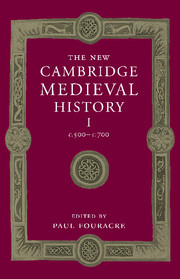Book contents
- Frontmatter
- Introduction: the history of Europe 500–700
- 1 The later Roman Empire
- 2 The Barbarian invasions
- 3 The sources and their interpretation
- PART I THE SIXTH CENTURY
- PART II THE SEVENTH CENTURY
- PART III THEMES AND PROBLEMS
- 20 The Jews in Europe 500–1050
- 21 Kings and kingship
- 22 The Mediterranean economy
- 23 The Northern Seas (fifth to eighth centuries)
- 24 Money and coinage
- 25 Church structure and organisation
- 26 Christianisation and the dissemination of Christian teaching
- 27 Education and learning
- 28A Art and architecture of western Europe
- 28B Art and architecture: the East
- List of Primary sources
- Bibliography of secondary works arranged by chapter
- Index
- Frontispiece"
- Plate section"
- Map 3 Gaul/Francia in the sixth and seventh centuries"
- References
21 - Kings and kingship
from PART III - THEMES AND PROBLEMS
Published online by Cambridge University Press: 28 March 2008
- Frontmatter
- Introduction: the history of Europe 500–700
- 1 The later Roman Empire
- 2 The Barbarian invasions
- 3 The sources and their interpretation
- PART I THE SIXTH CENTURY
- PART II THE SEVENTH CENTURY
- PART III THEMES AND PROBLEMS
- 20 The Jews in Europe 500–1050
- 21 Kings and kingship
- 22 The Mediterranean economy
- 23 The Northern Seas (fifth to eighth centuries)
- 24 Money and coinage
- 25 Church structure and organisation
- 26 Christianisation and the dissemination of Christian teaching
- 27 Education and learning
- 28A Art and architecture of western Europe
- 28B Art and architecture: the East
- List of Primary sources
- Bibliography of secondary works arranged by chapter
- Index
- Frontispiece"
- Plate section"
- Map 3 Gaul/Francia in the sixth and seventh centuries"
- References
Summary
introductory: a world of kings
Throughout the first millennium ad, much of the known world was ruled by monarchies. A good part of it has been for most of the second. In the first millennium bc, a number of the most self-confident societies were not. The records of the Jewish, Greek and Roman cultures that underpin European civilisation are laden with suspicion of individualistic authority. Nothing can be less readily assumed than that kings or emperors are the natural order of things.
Discussion of early medieval monarchy ought therefore to begin with a glance at the anti-monarchical traditions of the cultures most admired in the early Middle Ages. The Old Testament provided early medieval rulers with one of their main role models, and the Books of Kings would have been familiar for anyone exposed to basic Judaeo-Christian teaching. This was not a good advertisement for royal rule. Samuel prophesied that a king would make God’s people his slaves, when the Israelites insisted that he provide them with one. What followed was a catalogue of deviants and backsliders. Sixth- and seventh- century Europeans with only marginal education could also have known of the fall of the kings of Rome. Isidore of Seville, in the period’s most influential epitome of kingship, derived rex from regere, in the sense not only of ‘ruling’ but also of ‘doing right’ (recte facere) and ‘putting right’ (corrigere). ‘Hence the ancient proverb’, he wrote, ‘you will be king if you do right; if you do not, you will not.’ For when the Romans could not tolerate the proud domination of kings, they organised annual governments and a pair of consuls; for the marks of kingship were not benevolence in counsel but pride in dominance.
Keywords
Information
- Type
- Chapter
- Information
- The New Cambridge Medieval History , pp. 571 - 604Publisher: Cambridge University PressPrint publication year: 2005
References
Accessibility standard: Unknown
Why this information is here
This section outlines the accessibility features of this content - including support for screen readers, full keyboard navigation and high-contrast display options. This may not be relevant for you.Accessibility Information
- 3
- Cited by
